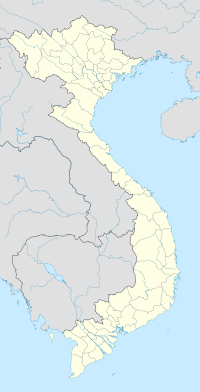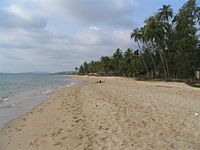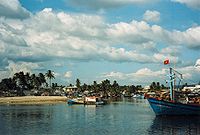- Phu Quoc
-
Coordinates: 10°13′44″N 103°57′26″E / 10.22889°N 103.95722°E
Phú Quốc (known as Koh Tral by Cambodians) is the largest island in Vietnam. The island is part of Kiên Giang Province, has a total area of 574 square kilometres (222 sq mi) and a permanent population of approximately 85,000[1]. The district of Phú Quốc includes the island proper and 21 smaller islets. The district seat, Dương Đông, is located on the west coast, and is also the largest town on the island. The economy is centered around fishing, agriculture and a fast-growing tourism sector; Phú Quốc being one of the most popular tourist destinations of Vietnam.
Contents
Geography
Located in the Gulf of Thailand, Phú Quốc island lies just off the Cambodian coast, 62 nautical miles (115 km; 71 mi) from Rạch Giá, 8.1 nautical miles (15.0 km; 9.3 mi) from Kampot province of Cambodia, and nearly 290 nautical miles (540 km; 330 mi) from Laem Chabang, Thailand. Roughly triangular in shape the island is 50 kilometres (31 mi) long north to south and 25 kilometres (16 mi) east to west in the north at its widest.
A mountainous ridge known as "99 Peaks" runs the length of Phú Quốc, with Chúa Mountain being the tallest at 603 metres (1,978 ft).
The island's monsoonal sub-equatorial climate is characterized by distinct rainy (June to November) and dry seasons (December to May). The annual rainfall is high, averaging 2,879 millimetres (9.446 ft). In the northern mountains up to 4,000 millimetres (13 ft) has been recorded. April and May are the hottest months, with temperature reaching 35 °C (95 °F).
Economy
Phu Quoc is famous for its two traditional products: fish sauce and black pepper. The rich fishing grounds offshore provides the anchovy catch from which the prized sauce is made. Pepper cultivation is located inland in the center of the island. More recently a pearl farm was established.
Tourism plays an important part of the economy with the beaches being the main attraction. Phu Quoc is served by Phu Quoc Airport with air links to Ho Chi Minh City (Saigon)'s Tan Son Nhat Airport and Rach Gia's Rach Gia Airport. Plans are in progress for a new international airport for the island. Phu Quoc is also linked with Rach Gia and Hà Tiên by fast ferry hydrofoils.[citation needed]
Air Mekong has its headquarters in An Thoi, Phú Quốc.[2][3]
History
An 1856 record mentions the island: "... King Ang Duong (of Cambodia) apprise Mr. de Montigny, French envoy in visit to Bangkok, through the intermediary of Bishop Miche, his intention to yield Phu Quoc to France[4]. Such a proposition aimed to create a military alliance with France to avoid the threat of Vietnam on Cambodia. The proposal did not receive an answer from the French[5].
While the war between Vietnam, France, and Spain was about to begin, Ang Duong sent another letter to Napoleon III to warn him on Cambodian claims on the lower Cochinchina region: the Cambodian king listed provinces and islands, including Phu Quoc, under Vietnamese occupation for several years or decades (in the case of Saigon, some 200 years according to this letter). Ang Duong asked the French emperor to not annex any part of these territories because, as he wrote, despite this relatively long Vietnamese occupation, they remained Cambodian lands. In 1867, Phu Quoc's Vietnamese authorities pledged allegiance to French troops just conquering Hà Tiên.
After Cambodia gained independence from France, sovereignty disputes over the island were raised since there was no colonial decision on the island's fate. Dating back to 1939, the Governor-general of French Indochina, Jules Brévié had drawn a line to delimit the administrative boundaries for islands in the Gulf of Thailand: those north of the line were placed under the Cambodian protectorate; those south of the line were managed by the colony of Cochinchina. Brévié made the point that the decision merely addressed police and administrative task, and that no sovereignty decision had been made. As a result, Phu Quoc remains under Cochinchina administration.
Phu Quoc has been a sleepy historical backwater for most of its history. The temple on Cau rock was built in 1937. During the Vietnam War the island housed South Vietnam's largest prisoner camp (40000 in 1973, [6].
After Mainland China fell under the control of the Chinese Communist Party in 1949, General Huang Chieh led 30,000 Republic of China Army soldiers to Vietnam and they were stationed at Phu Quoc. Later, the army moved to Taiwan in June 1953[7]. There is currently a small island in Kaohsiung, Taiwan's Chengcing Lake that was constructed in November 1955 and named Phu Quoc Island in memory of the fleeing Chinese soldiers in 1949.
In 1967, during the Sangkum Reastr Niyum, Norodom Sihanouk aimed to make the border internationally recognized; in particular, in 1967, the North Vietnamese government recognize theses borders. As written in an article from Kambudja magazine in 1968 (and quoted in the Sihanouk website), entitled "border questions", this border definition recognize that Phu Quoc island is in Vietnamese territory, even if Cambodian claims were made later.
On May 1, 1975, a squad of Khmer Rouge soldiers raided and took Phu Quoc Island, but Vietnam soon recaptured it. This was to be the first of a series of incursions and counter-incursions that would escalate to the Cambodian–Vietnamese War in 1979.
Pictures
References
- ^ http://www.phuquoc.info/general.htm
- ^ "About Us." Air Mekong. Retrieved on December 21, 2010. "Headquaters: [sic]Hamlet 3, Village 7, An Thoi Town, Phu Quoc Island, Kiên Giang Province, Vietnam..."
- ^ "Website usage terms and conditions." Air Mekong. Retrieved on December 21, 2010
- ^ "Le Second Empire en Indo-Chine (Siam-Cambodge-Annam): l'ouverture de Siam au commerce et la convention du Cambodge”, Charles Meyniard, 1891, Bibliothèque générale de géographie
- ^ "La Politique coloniale de la France au début du second Empire (Indo-Chine, 1852-1858)", Henri Cordier, 1911, Ed. E.J. Brill
- ^ Ngo Cong Duc, deputy of the Vinh Binh province, quoted in "Le régime de Nguyen Van Thieu à travers l'épreuve", Etude Vietnamienne, 1974, pp. 99–131
- ^ 2009年03月31日, 抗日名将黄杰与最后一支离开大陆的国民党部队, 凤凰资讯
External links
 Districts of the Mekong Delta Region
Districts of the Mekong Delta RegionCan Tho 
An Giang province Long Xuyen · An Phu · Chau Phu · Chau Thanh · Cho Moi · Phu Tan · Tan Chau · Thoai Son · Tinh Bien · Tri TonBac Lieu province Ben Tre province Ben Tre · Ba Tri · Binh Dai · Chau Thanh · Cho Lach · Giong Trom · Mo Cay Bac · Mo Cay Nam · Thanh PhuCa Mau province Dong Thap province Cao Lanh · Sa Dec · Chau Thanh · Hong Ngu Town · Hong Ngu District · Lap Vo · Tan Hong · Tam Nong · Thanh Binh · Thap MuoiHau Giang province Kien Giang province Rach Gia · An Bien · Chau Thanh · Giong Rieng · Go Quao · Giang Thanh · Hon Dat · Kien Hai · Kien Luong · Tan Hiep · Vinh Thuan · U Minh ThuongLong An province Soc Trang province Soc Trang · Chau Thanh · Ke Sach · Long Phu · Cu Lao Dung · My Tu · My Xuyen · Thanh Tri · Vinh Chau · Nga NamTien Giang province My Tho · Chau Thanh · Cai Lay · Cai Be · Go Cong • Cho Gao • Go Cong Dong • Go Cong Tay • Tan Phuoc • Tan Phu DongTra Vinh province Vinh Long province Categories:- Islands of Vietnam
- Districts of Kien Giang Province
- Gulf of Thailand
- Islands of the South China Sea
Wikimedia Foundation. 2010.























